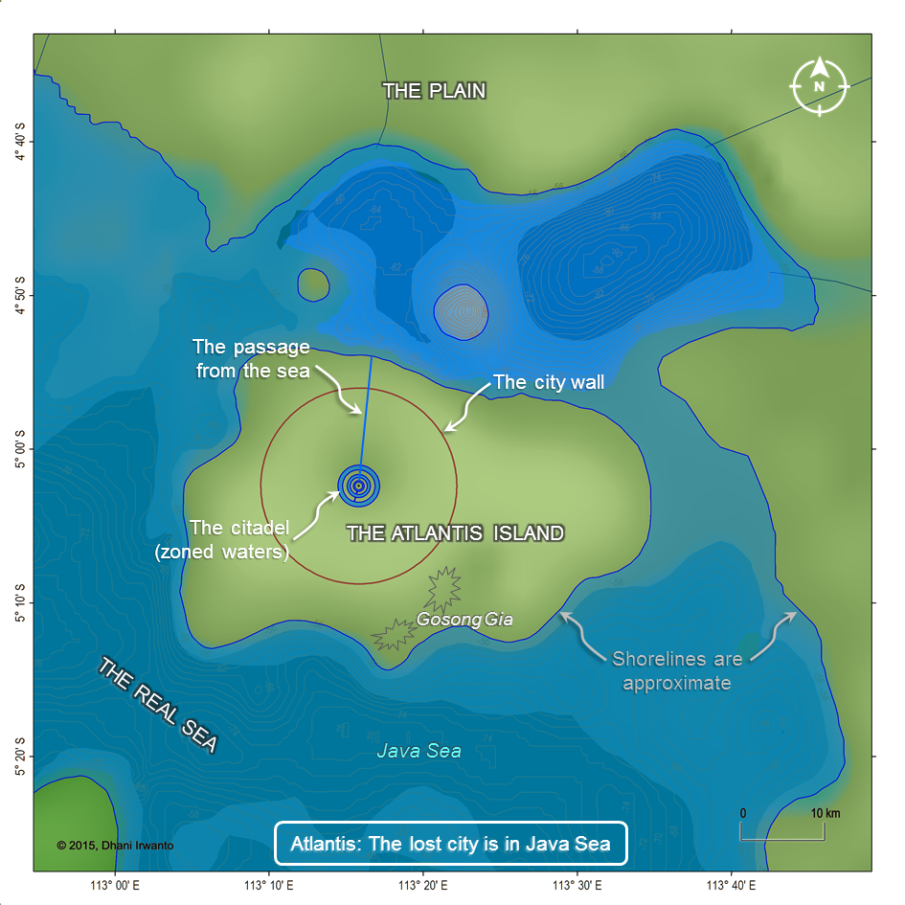By Dhani Irwanto, 18 August 2015

From Plato’s Timaeus Section 25d: “For which reason the sea in those parts is impassable and impenetrable, because there is a shoal of mud in the way; and this was caused by the subsidence of the island.”
“A shoal of mud” is the generally published translation of the Ancient Greek phrase “πηλοῦ κάρτα βραχέος” written by Plato. “κάρτα βραχέος” is not syntactically good and it is not found in any manuscript; “πηλός” is masculine and is the antecedent of the relative pronoun; “κατὰ βραχέος”, for its turn, is adverbial. The simple meanings of the words are: πηλοῦ for “clay” or “mud”, κάρτα for “very” and βραχέος for “shoal” or “reef”. Other alternative translation is “the clay that exists in large quantity there and of the small depth” (Lopes, 2011).
The author translated πηλοῦ κάρτα βραχέος into “coral reef” for the reason that this sea formation is scarce in the Mediterranean so that the Greeks and the Egyptians did not own the term. The Mediterranean no longer shelters the great coral reefs that thrived 60 million years ago. This is due to millennia of climactic and oceanographic changes. Today, there are only a few species of colonial anthozoans that have the capacity to create the coral reefs. In 2010, the exploration vessel Nautilus has discovered for the first time an area of reefs with deep-sea corals in the Mediterranean, offshore of Israel. This area apparently stretches over a few kilometers, 700 meters under the surface and some 30 – 40 km off the coast.
In the above Plato’s account, the citadel of Atlantis was impassable and impenetrable at the time of Solon (about 600 BC) because of the growth of a coral reef caused by sea level rise during the Ice Age (“subsidence of the island”). The present condition of the hypothesized site is that there is a coral reef identified by the sailors as Gosong Gia or Annie Florence Reef, a coral reef described as small in extent and dries at low water.
Coral reefs are diverse underwater ecosystems held together by calcium carbonate structures secreted by corals. Coral reefs are built by colonies of tiny animals found in marine waters that contain few nutrients. Most coral reefs are built from stony corals, which in turn consist of polyps that cluster in groups. The polyps belong to a group of animals known as Cnidaria, which also includes sea anemones and jellyfish. Unlike sea anemones, corals secrete hard carbonate exoskeletons which support and protect the coral polyps. Reefs grow best in warm, shallow, clear, sunny and agitated waters.
Often called “rainforests of the sea”, shallow coral reefs form some of the most diverse ecosystems on Earth. They occupy less than 0.1% of the world’s ocean surface, about half the area of France, yet they provide a home for at least 25% of all marine species, including fish, molluscs, worms, crustaceans, echinoderms, sponges, tunicates and other cnidarians. Paradoxically, coral reefs flourish even though they are surrounded by ocean waters that provide few nutrients. They are most commonly found at shallow depths in tropical waters, but deep water and cold water corals also exist on smaller scales in other areas.
Coral reefs begin to form when free-swimming coral larvae attach to submerged rocks or other hard surfaces along the edges of islands or continents. As the corals grow and expand, reefs take on one of three major characteristic structures – fringing, barrier or atoll. Fringing reefs, which are the most common, project seaward directly from the shore, forming borders along the shoreline and surrounding islands. Barrier reefs also border shorelines, but at a greater distance. They are separated from their adjacent land mass by a lagoon of open, often deep water. If a fringing reef forms around a volcanic island that subsides completely below sea level while the coral continues to grow upward, an atoll forms. Atolls are usually circular or oval, with a central lagoon. Parts of the reef platform may emerge as one or more islands, and gaps in the reef provide access to the central lagoon (Lalli and Parsons, 1995; Levinton, 1995; Sumich, 1996 as cited by NOAA).
In addition to being some of the most beautiful and biologically diverse habitats in the ocean, barrier reefs and atolls also are some of the oldest. With growth rates of 0.3 to 2 centimeters per year for massive corals, and up to 10 centimeters per year for branching corals, it can take up to 10,000 years for a coral reef to form from a group of larvae (Barnes, 1987 as cited by NOAA). Depending on their size, barrier reefs and atolls can take from 100,000 to 30,000,000 years to fully form.
The citadel of Atlantis consisted of hard surfaces so that a coral reef began to form in a while after its submergence, grows and expands as commonly found at shallow depths in tropical waters. Any underwater explorations may not find the citadel unless they made investigations under the reef.
The rate of seawater rise in the Last Glacial Period is in average 0.6 centimeter per year. Because of the warm water at the hypothesized site, the growth rate of the coral reef is expectedly higher than the rate of seawater rise. Accordingly, the vertical growth rate of the coral reef at the site is parallel to the seawater rise.
Citations
- Rodolfo Lopes, Platão, Timeu-Crítias. Tradução do grego, introdução e notas, Centro de Estudos Clássicos e Humanísticos, 2011
- OCEANA, The Corals of the Mediterranean. http://oceana.org/reports/corals-mediterranean
- Wikipedia, Coral reef. https://en.wikipedia.org/wiki/Coral_reef
- NOAA, How Do Coral Reefs Form?http://oceanservice.noaa.gov/education/kits/corals/coral04_reefs.html
***






No comments:
Post a Comment